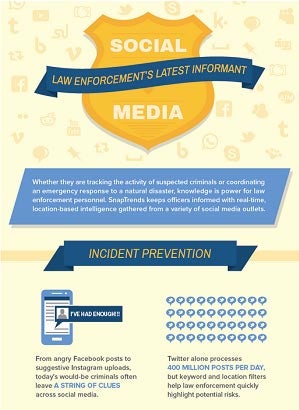The promise to local police departments is simple: Buy our software, and we will help you prevent crime before it happens. How? Through a social media “listening lens.”
Called “SnapTrends,” the web-based service sifts through every Facebook status, Tweet, Instagram photo, YouTube video and other social media post within a designated area. That “listening lens” can be focused on “any size or shaped area you want, as big as a country or as small as a city block.” Racine, Wisc. officials voted to buy the software on Wednesday; it might come to your town soon.
Brochures and whitepapers hawking the system promise “incident prevention” from “predictive analysis.” SnapTrends is dubbed “law enforcement’s latest informant.” It even promises to monitor the posts and movements of journalists and protestors.

SnapTrends law enforcement brochure
In a daring boast to show off the “power” than “emanates” from SnapTrends, the firm’s website includes a button that says, “See the Power.” Click there, and you’ll be urged to “give us something to find in your area.” Then, “Examples: Find someone in Seattle, Washington talking about cocaine.”
An infographic designed for law enforcement includes a picture of a smartphone with a message on it reading, “I’ve had enough!!” – suggested an enraged user hinting through a status update that he or she is ready to commit violence — under the headline “incident prevention.”
Several products promise to help government organizations and corporations monitor social media chatter, but SnapTrends says its product is superior because its listening lens can be fine-tuned geographically. There is an emphasis on its predictive abilities.
“Accessing data in real time is critical to law enforcement officials who don’t want to squander an opportunity to stop criminal behavior before it starts,” reads one bit of marketing material. “SnapTrends enables you to leverage open social networks to spot ‘chatter’ that might give an indication that trouble is about to happen,” says another.
While such chatter might sound right out of the Department of PreCrime from the movie The Minority Report, SnapTrends is actually on sale now to local police departments across America. The city of Racine, Wisc. voted Wednesday night to skip its normal bidding process and direct $4,200 in crime-seized funds for a subscription to SnapTrends, offered by an Austin, Texas, firm of the same name that opened for business in 2012. The vote was 14-1. When local officials questioned police about potential civil liberties concerns, Police Chief Art Howell soothed those concerns.
“I can almost assure you that there is enough stuff going in this town that we don’t have idle time to surf the internet,” Howell said, according to local newspaper The Journal Times. The news came as the second item in a typical city council story which was headlined, “More window signs allowed,” about an ordinance permitting stores to hang more signs, which was far more controversial.
Howell refused an interview for this story – and SnapTrends did not respond to an interview request — but I had a brief exchange with Sgt. Jessie Metoyer, Racine police public information officer, over email.
“We can’t provide specifics regarding our investigative tools, tactics and strategies, including SnapTrends, as that could compromise future investigations. We believe doing so would undermine our local investigative effort and would not want to jeopardize that. Publicizing our investigative strategies could harm criminal investigations,” she said. “This technology, which is utilized by law enforcement across the country, would strictly be used for criminal investigation purposes.”
SnapTrends is aggressively marketing its products to law enforcement, with some success. Earlier this year, Coral Gables, Fla. agreed to pay $10,500 for a year’s subscription to the software.

Composite from SnapTrends.com
Metoyer also pointed to a recent crime-related success with social media monitoring. The gruesome murder of a teenager in Racine was recently solved in part because police found a rap video posted by the suspect on SoundCloud, a music sharing website. Lyrics from the video, which seem to mention the murder, sound like admission to a crime and were included in the criminal complaint.
But in some cities, civil liberties advocates have raised alarm bells about the technology. When the sheriff’s office in El Paso, Texas, considered buying SnapTrends, there were complaints about potential civil liberties impacts.
“What becomes concerning is if they’re monitoring First Amendment activity, any effort like this has to be very careful and clear that First Amendment activity is not the basis for any criminal investigation,” said Matt Simpson, of the Texas ACLU, according to GovTech.com. He also warned, “It’s easy to take things out of context online.”
SnapTrends makes the case throughout its marketing materials that its software merely collects publicly available information and makes sense out of it for law enforcement.
“There is a common misconception that social media monitoring software allows users to spy on their subjects and access their personal information. However, that is simply not the case. Social media listening tools scan sites like Facebook, Twitter and Instagram and other open source pieces of information for certain keywords and phrases and gathers the data to see specific trends,” the firm says in one blog entry.
While the firm makes a case that it only gathers items that Internet users have already deemed suitable for public consumption, not long ago the firm bragged about its ability to go deeper than users imagine when they write posts. The firm’s biggest selling point is its ability to geolocate posts – apparently even if users don’t want to be geolocated. In a story published on Quartz in July, a SnapTrends official bragged that the firm could place subjects who refuse to geo-tag Tweets and disabled GPS.
“If it’s a dense environment. I can put you within a block. If it’s a [bad] environment I can put you within two or three blocks,” said Todd Robinson, who according to Quartz is director of operations for Defense Military Intelligence for the company General Dynamics Information Technology, GDIT, and SnapTrends president for Middle Eastern operations. GDIT partnered with SnapTrends to sell their services to the government. “Once I do have you, I click this button right here, I can go back five years [of social media posts.]”
The firm uses “cell tower density, social network knowhow, and various other elements to figure out who is posting what and where,” the story says.
Still, a whitepaper designed for law enforcement tries to allay any concerns about Constitutional rights.
“From a larger legal perspective, questions are developing for public safety organizations asking: Is monitoring social media a violation of individual privacy rights? All individual subscribers of social media services should understand anything posted publicly via a social service has been voluntarily placed in the public domain,” it says. “The standard legal test is this: Do you have a reasonable expectation of privacy with social media? There is a strong argument that one has a reasonable expectation of privacy with private settings and no expectation with open settings.”
The standard legal test also concerns fishing expeditions. They’re not allowed, unless you are a federal agency working under some kind of national security exception, a lesson Ed Snowden reminded us about. Law enforcement searches must be focused, targeted and generally require some level of reasonable suspicion. There is a high level of interest in not having police attend every gathering of citizens – virtually or otherwise – and listen to their discussions. Doing so would have a chilling effect on conversation, and ultimately lead to infringement of the First Amendment’s right to speech. So when El Paso County Sheriff Deputy Jesse Tovar told Govtech.com, “We’re not focusing on anybody in particular…It’s a public safety resource tool, not spying,” his argument is unconvincing to those worried about fishing expeditions.
“Assuming that the product is confined to information that is public like a Tweet, then in general there are no Fourth Amendment issues with law enforcement accessing it, but I think there are serous policy issues about the question of whether we want law enforcement to spend time and resources monitoring the online activity of Americans without any kind of reasonable suspicion,” said Jay Stanley, senior policy analyst with the ACLU’s Speech, Privacy and Technology Project. “Suspicionless dragnets inevitably lead to profiling and have tremendous potential to create chilling effects. We don’t want Americans to pause when they type a tweet and think about law enforcement looking over (their) shoulders.”
Stanley was also skeptical of the software’s ability to do what SnapTrends claims, such as provide locations for Tweets even if users turn off GPS services. Most of all, he said, the notion of predicting crime from social media posts was misguided.
“There’s a seductive quality to online evidence. When we’ve seen somebody whose done something bad, we see all the precursors to the crime (online) and think, ‘If only we looked at it ahead of time we could have prevented it.’ But the problem is it only works in retrospect,” Stanley said. “For every person who does something bad after an angry post, there are tens and thousands who wrote angry posts with no intention of ever committing a crime. This will flood law enforcement with false positives.”
Brad Shear, a social media law expert based in Washington, D.C., who has led the charge against blanket monitoring of students’ social media posts by schools, said he’d never heard of SnapTrends. But he had a series of questions about it.
“Does this work? What type of regulations will be in place regarding collecting, archiving and acting upon the data law enforcement is receiving? How long will the content be saved,” he asked, and continued. “Who will have access to it? How will the police determine if a Tweet is a lyric to a new hit song or a clear and present danger to public safety? Will the generated social media monitoring reports be available to the public under an open records request? Is the social media monitoring company selling the information it is collecting under the contract to third parties?
Without law enforcement agencies or the software company involved answering questions, it will be hard to get the answers. Without those answers, all social media monitoring should immediately stop, argues Jeramie D. Scott, National Security Counsel at the Electronic Privacy Information Center.
“Law enforcement monitoring of social media implicates the First Amendment. Government programs that threaten important First Amendment rights are immediately suspect and should only be undertaken where the government can demonstrate a compelling interest that cannot be satisfied in another way,” he said. “Any law enforcement agency should cease social media monitoring until the polices and procedures applicable to the program are made public. Although law enforcement may claim that these programs are narrowly tailored and do not threaten First Amendment protected activities, until law enforcement agencies provide the necessary transparency to ensure proper oversight and accountability, it is mere lip service.”
More on Identity Theft:
- How Do I Dispute an Error on My Credit Report?
- 3 Dumb Things You Can Do With Email
- How Credit Impacts Your Day-to-Day Life
This article originally appeared on BobSullivan.net.
Main image: woolzian; inset images courtesy BobSullivan.net
You Might Also Like
September 13, 2021
Uncategorized
August 4, 2021
Uncategorized
January 28, 2021
Uncategorized





